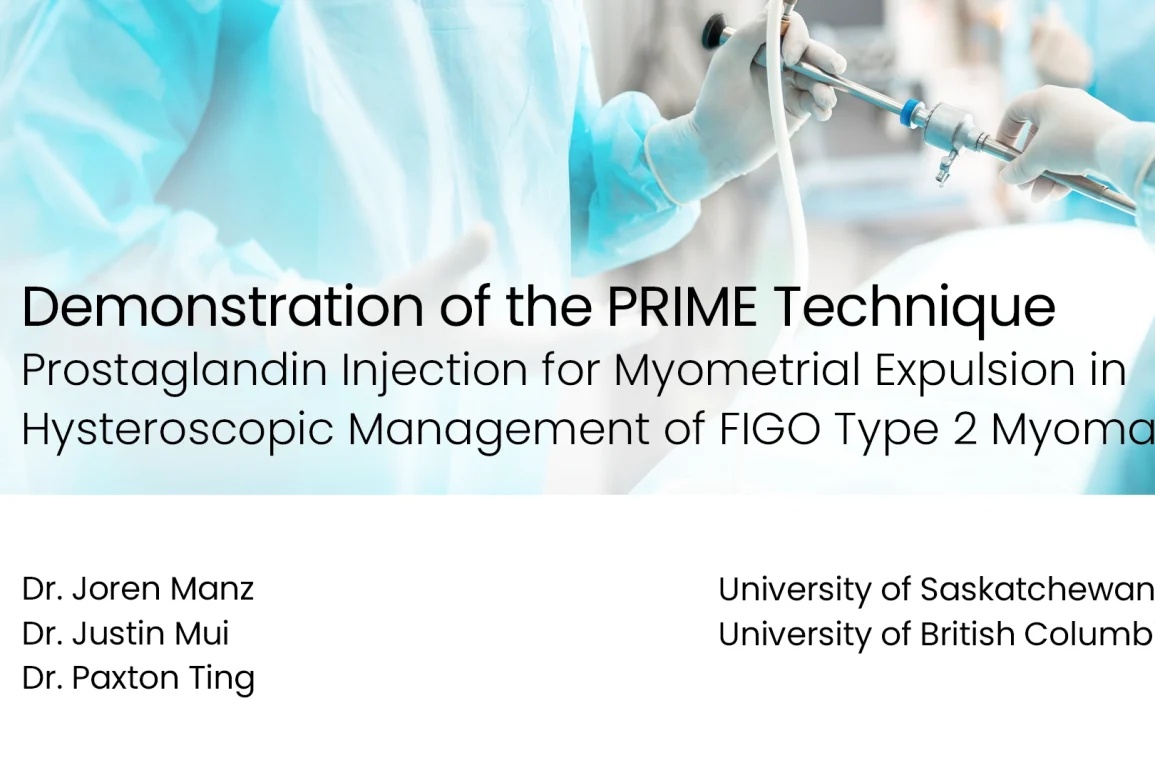Table of Contents
- Procedure Summary
- Authors
- Youtube Video
- What is Prostaglandin Injection for Myometrial Expulsion?
- What are the Risks of Prostaglandin Injection for Myometrial Expulsion?
- Video Transcript
Video Description
Watch the PRIME technique in action—using prostaglandin injection to induce myometrial expulsion during hysteroscopic fibroid removal, enhancing efficiency and safety.
Presented By
Affiliations
University of Saskatchewan, University of British Columbia
Watch on YouTube
Click here to watch this video on YouTube.
What is Prostaglandin Injection for Myometrial Expulsion?
Prostaglandin Injection for Myometrial Expulsion (PRIME technique) is a hysteroscopic method used to facilitate the removal of FIGO Type 2 submucosal fibroids. Key aspects include:
-
Purpose: Type 2 fibroids are challenging to resect because more than 50% of the lesion is embedded in the myometrium. PRIME uses prostaglandin to stimulate uterine contractions, helping to expel the intramural portion into the uterine cavity so the fibroid can be treated as a more accessible Type 1 lesion.
-
Mechanism: A dilute solution of carboprost (a prostaglandin analogue) is injected hysteroscopically along the border of the fibroid and endometrium. The prostaglandin binds to smooth muscle receptors, inducing rapid myometrial contractions that push the fibroid into the cavity.
-
Procedure: After initial hysteroscopic dissection to the endometrial plane, a rigid endoscopic needle is used to inject small volumes (about 1–2 cc per site) of the carboprost solution into several points around the fibroid. Expulsion typically occurs within minutes, allowing immediate continuation of hysteroscopic resection.
-
Clinical Advantage: This approach reduces the need for repeat procedures, accelerates symptom relief, and may shorten the time to fertility treatment by achieving complete fibroid removal in a single session.
What are the Risks of Prostaglandin Injection for Myometrial Expulsion?
While generally safe and performed under direct visualisation, this technique carries potential risks that require careful monitoring.
-
Uterine Complications: Excessive contractions may distort the cavity, increasing the risk of accidental myometrial dissection or uterine perforation.
-
Bleeding: Injection sites can bleed due to myometrial disruption or inadvertent vessel injury.
-
Medication Side Effects: Carboprost can cause cramping, transient hypertension, flushing, nausea, vomiting, diarrhea, or bronchospasm, though doses used are far lower than those in postpartum hemorrhage management.
-
Incomplete Expulsion: In some cases, the fibroid may not fully migrate into the cavity, necessitating additional injections or repeat surgery.
-
Infection: Any intrauterine procedure carries a small risk of endometritis or postoperative infection.
Meticulous hysteroscopic technique, accurate needle placement, and appropriate patient selection help minimize these complications while allowing effective management of difficult Type 2 fibroids.
Video Transcript:
Demonstration of the PRIME Technique. Prostaglandin Injection for Myometrial Expulsion in Hysteroscopic Management of FIGO Type 2 Myomas. We have no conflicts of interest, and patient consent was obtained.
Fibroids are the most common gynaecological tumour, with a prevalence of up to 70 to 80% by the age of 50. About 20 to 50% of patients are symptomatic. These symptoms can include heavy menstrual or abnormal uterine bleeding, recurrent pregnancy loss, as well as problems with infertility. These symptoms are due to the effect of submucosal lesions that distort the endometrial cavity or that are adjacent to the endometrium.
Treatment is individualised, depending on the patient’s symptoms, location and size of the fibroids. Both Canadian and American guidelines recommend hysteroscopic resection as a first line therapy for the management of symptomatic submucosal fibroids. Fibroids are classified by their FIGO Type classification system, or Type 0 as a pedunculated intracavitary fibroid. Type 1 would have less than 50% myometrial component, and Type 2 would have a greater than 50% myometrial component.
Historically, Type 1 and Type 0 fibroids are usually managed hysteroscopically. On the other hand, Type 2 fibroids are more difficult to manage, owing to the relative inaccessibility of the intra-myometrial component of the fibroid, and often require repeat procedures for complete resection. It may take months for the remaining intramural portion of the myoma to migrate into the cavity, at which time patients may continue to experience significant symptoms and delay fertility procedures.
Cromack, et al, recently published a novel surgical technique for the management of Type 2 fibroids by utilising the action of prostaglandins to induce myometrial contractions to expel intramural fibroids into the cavity. They coined this, the PRIME Technique, or Prostaglandin Injection for Myoma Expulsion. With the expulsion of Type 2 fibroids into the endometrial cavity, this would effectively allow us to manage these as a Type 1 fibroid.
Carboprost is a synthetic analogue of a naturally occurring prostaglandin, that when binds to receptors on smooth muscle cells, will induce contractility. Carboprost was chosen as it is readily available and already accessible in many hospital settings, as it is often used in obstetrics for the management of postpartum haemorrhage.
We follow the steps for solution preparation described in their paper. Carboprost comes in a concentration of 250 micrograms in a 1 ml vial. We simply dilute this by drawing it up into 25 ml of normal saline in a 30 ml syringe. This produces a ten microgram per/ml concentration. A standard hysteroscopic myometrial resection is performed until the Type 2 fibroid is flushed with the plane of the endometrium.
Next, we inserted a 23 gauge, rigid endoscopic needle attached to our syringe through the operative port of the hysteroscope. This technique allows for easy transitioning between the needle and the tissue removal device, while maintaining direct visualisation of our field.
We then injected one to two cc’s, about half the dose used in the paper, of the ten microgram per mil solution, at approximately three to four sites along the fibroid and endometrial border, to a depth of approximately 3 to 6 mm. Expulsion of the fibroid into the cavity occurs within seconds, and dissection is continued immediately.
Here, we can visualise a Type 2 fibroid extending into the endometrial cavity, posteriorly. Dissection is then carried down, as normally done to be flush with the endometrium. We can clearly see from this angle that it will be difficult to continue dissection any further.
While maintaining visualisation of our field, the tissue removal device handle is removed and the rigid endoscopic needle is inserted. Here we demonstrate the border between the fibroid and the endometrium. An injection is carried out along this junction. Markers along the tip of the needle allow us to inject at accurate depth.
Approximately 1 to 2 cc’s of this solution was injected in three sites. We can see that almost immediately contractions begin, and the fibroid begins expulsing into the cavity. After only two and one half minutes, a significant portion of the intramural fibroid has now extended into the cavity.
We can see by comparing the angle between the endometrium and the fibroid, before and after injection, that the Type 2 fibroid can now effectively be managed similar to a Type 1.
In this next case, we demonstrate that this technique can be adapted to varying fibroid sizes and depths of myometrial components, necessitating multiple rounds of dissection and injections. Again, in real time, we can visualise the expulsion of the fibroid. Repeated injection allowed for further expulsion of the fibroid into the cavity.
As dissection continued, the visualisation of our cavities start to change. In pulling back for a global view, we could now appreciate the effects that contraction had on our visual field. Throughout the procedure, there were times where we could visualise active myometrial contraction.
We could see here that contractions led to the formation of concentric rings. While continuing our dissection, with the effects that contractions have on distorting the cavity and altering our visual field, it is important to maintain awareness where one is in the cavity during dissection, to ensure only dissection of fibroid tissue, and avoiding myometrial dissection and perforations.
In summary, we demonstrated the ease of adaptation and reproducibility of a novel hysteroscopic technique for the management of Type 2 fibroids, and showed validation in our own patients. This technique was relatively simple to set up and easy to use. Carboprost is readily available and accessible in many centres, and solution preparation was straightforward.
The targeted and controlled injection of this dilute solution effectively induced contractions, while delivering a significantly smaller dose than what is typically administered during postpartum haemorrhage management. As such, we would expect to see minimal side effects from this medication in our patients, ensuring a normal post-operative course.
The rigid endoscopic needle inserted through the operative part of the scope, allowed us to maintain visualisation of our field, while easily transitioning between injection and dissection. The potential that this technique has on improving the outcomes of patients with Type 2 fibroids includes the avoidance of requiring multiple procedures, faster management of symptoms, and faster return to fertility.
I’d like to thank Dr Mui and Dr Ting for additional footage required to complete this video, and certainly this could not have been done without the original work and refined technique, well described by Cromack, et al.



